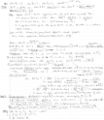12-240/Classnotes for Tuesday September 18: Difference between revisions
No edit summary |
|||
| Line 86: | Line 86: | ||
In any factorization of m, one of the factors is m and the other is 1. So m is prime. ∎ |
In any factorization of m, one of the factors is m and the other is 1. So m is prime. ∎ |
||
== Complex number == |
|||
Consider a fact that ∄ x <math>\in\!\,</math> R s.t x^2=-1 |
|||
=> Add a new number i to R so as to get a field containing i^2=-1. |
|||
''' |
|||
Definition''''''Bold text''' |
|||
== Lecture 3, scanned notes upload by [[User:Starash|Starash]] == |
== Lecture 3, scanned notes upload by [[User:Starash|Starash]] == |
||
Revision as of 22:29, 18 September 2012
| |||||||||||||||||||||||||||||||||||||||||||||||||||||||||
The professor continued with some theorems about field and moved on to the definition of complex number
Various properties of fields
Thrm 1: In a field F: 1. a+b = c+b ⇒ a=c
2. b≠0, a∙b=c∙b ⇒ a=c
3. 0 is unique.
4. 1 is unique.
5. -a is unique.
6. a^-1 is unique (a≠0)
7. -(-a)=a
8. (a^-1)^-1 =a
9. a∙0=0 **Surprisingly difficult, required distributivity.
10. ∄ 0^-1, aka, ∄ b∈F s.t 0∙b=1
11. (-a)∙(-b)=a∙b
12. a∙b=0 iff a=0 or b=0
. . .
16. (a+b)∙(a-b)= a^2 - b^2 [Define a^2 = a∙a] Hint: Use distributive law
Thrm 2: Given a field F, there exists a map Ɩ: Z → F with the properties (∀ m,n ∈ Z):
1) Ɩ(0) =0, Ɩ(1)=1
2) Ɩ(m+n) = Ɩ(m) +Ɩ(n)
3) Ɩ(mn) = Ɩ(m)∙Ɩ(n)
Furthermore, Ɩ is unique.
Rough proof:
Test somes cases:
Ɩ(2) = Ɩ(1+1) = Ɩ(1) + Ɩ(1) = 1 + 1 ≠ 2
Ɩ(3) = Ɩ(2 +1)= Ɩ(2) + Ɩ(1) = 1+ 1+ 1 ≠ 3
. . .
Ɩ(n) = 1 + ... + 1 (n times)
Ɩ(-3) = ?
Ɩ(-3 + 3) = Ɩ(-3) + Ɩ(3) ⇒ Ɩ(-3) = -Ɩ(3) = -(1+1+1)
What about uniqueness? Simply put, we had not choice in the definition of Ɩ. All followed from the given properties.
At this point, we will be lazy and simply denote Ɩ(3) = 3_f [3 with subscript f]
∃ m≠0, m ∈ N, Ɩ(m) =0
In which case, there is a smallest m<0, for which Ɩ(m)=0. 'm' is the characteristic of F. Denoted char(F). Examples: char(F_2)=2, char(F_3)=3... but NOTE: char(R)=0
Thrm: If F is a field and char(F) >0, then char(F) is a prime number.
Proof: Suppoer char(F) =m, m>0. Suppose also m is not prime: m=ts, t,s ∈ N.
Then, Ɩ(m) = 0 = Ɩ(t)∙Ɩ(s) ⇒ Ɩ(t)=0 or Ɩ(s)=0 by P12.
If Ɩ(t)=0 ⇒ t≧m ⇒ m=t, s=1 or likewise for Ɩ(s)=0, and m=s, t=1
In any factorization of m, one of the factors is m and the other is 1. So m is prime. ∎
Complex number
Consider a fact that ∄ x R s.t x^2=-1
=> Add a new number i to R so as to get a field containing i^2=-1. Definition'Bold text





